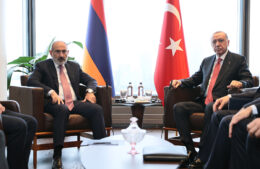From the Ottoman Empire to Killarney, Manitoba, Canada
- (0)
From the Ottoman Empire to Killarney, Manitoba, Canada

Dave Garabed holds a copy of the Winnipeg Evening Tribune from Aug. 8, 1923 that contains a short report of three Armenian youths brought to Canada by the Salvation Army. One of them was his father, Harry.
The Turkish authorities spared Harry’s life because they hoped to convert him to Islam. He was taken to an orphanage in Istanbul, where he was beaten, forcibly circumcised and held under appalling conditions until he escaped into the countryside.
Almost everyone is familiar with the 1981 film “Gallipoli,” which starred Mel Gibson as a soldier in the ill-fated attempt by the French and British to take Constantinople, now Istanbul, via a sea-based invasion during the early days of the First World War.
But the events of the day before, are much less well known, except to members of the Armenian disapora, who mark it as the start of the “Great Crime.”
Historians pinpoint April 24, 1915, as the beginning of the Armenian genocide. The government of the crumbling Ottoman Empire, which later became modern-day Turkey, arrested and executed 250 Armenian intellectuals and community leaders in Constantinople — a move that later sparked the wholesale extermination and expulsion of the country’s restive Christian minorities, including two million Armenians.
Enraged by the mass expulsions of Muslim refugees from European countries in the Balkan wars that started in 1912 as a prelude to the Great War, Wikipedia states that the “Young Turks” embarked on a systematic campaign of revenge and property confiscation that led to the deaths of as many as 1.5 million Armenians.
Men of military age were killed immediately, while the elderly, women and small children were marched off into the Syrian desert where most of them died.
The significance of the recently announced partnership between the Canadian Museum of Human Rights and the Armenian Genocide Museum Institute of the National Academy of Sciences may be lost on some, but not to Dave Garabed, a retired farmer who now lives on the shore of Killarney Lake.
He and his brother Jack are familiar with some of the details of what many historians now call the first genocide of the modern era because their father, Harry, survived it by escaping to Canada.
Harry Garabed, born Garabed Hartounian in 1906, was living in Kayseri, a small town in what is now northeastern Turkey. When the genocide started, he was about 10 years old.
“He watched them hang his father, right out in the street,” said Dave.
His mother and six siblings were taken away on a death march that may have taken them to Egypt — if they survived.
Apparently, the Turkish authorities spared Harry’s life because they hoped to convert him to Islam. He was taken to an orphanage in Istanbul, where he was beaten, forcibly circumcised and held under appalling conditions until he escaped into the countryside.
Dave said that his father, who passed away about 15 years ago, coped with his traumatic experiences the old-fashioned way.
“If you got a few drinks into Dad, he would tell stories, but he didn’t talk about it much,” said Dave.
“I remember him telling me a story of how they got cheese that was all full of maggots, so they found a piece of tin and put it in the sun to cook the maggots out,” said Dave.
After about six years, some of it spent in the orphanage and on the run, he was rescued by the Salvation Army and brought first to Greece, then Britain, and then Canada. From Montreal, he was taken by train to Winnipeg.
An Aug. 8, 1923 story discovered in the archives of the Winnipeg Evening Tribune,described Harry and two other Armenian boys as “thickset, strongly built lads” ready for work after partaking in a two-month Salvation Army farm training course in Britain.
“They took very readily to the work and are at present keen to settle down,” it added.
Even though his father spoke no English, the local farmers were happy to have him help out, and his first job was stooking sheaves at harvest time.
The two other boys headed back east to rejoin the growing Armenian community there, but Harry stayed with a local family for a few years. He later bought a seed-cleaning outfit, and then got into trucking before finally buying a farm in the Ninette area.
He served in the Second World War as a medic and cook, and later got involved in local politics as a councillor and reeve for the RM of Riverside.
Dave said that his father was grateful to Canada and the local community for accepting him as one of their own, but he was especially careful to remember the Salvation Army’s role in rescuing him.
“He’d never walk past a Salvation Army box without dropping something in it,” said Dave.
Jack and Dave attended the Armenian genocide partnership announcement at the CMHR in Winnipeg earlier this fall. As a practical farmer, he questions the elaborate structure’s $351-million cost, but not its value for teaching future generations the most important lessons of history.
“I think it’s worth having a museum, because if we don’t tell our kids about it, they’re never going to know what happened,” said Dave.
“I think Dad would be proud that Canadians have at least recognized the genocide.”
DANIEL WINTERS
Manitoba cooperator


















